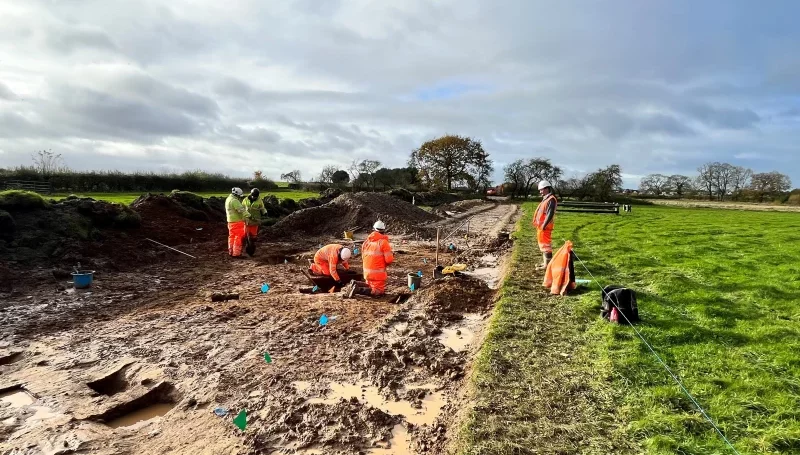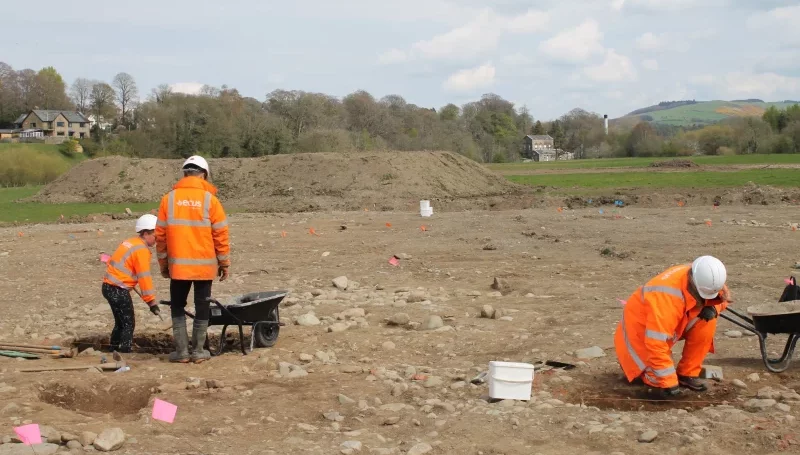The Roman Empire was a diverse place, spread across three continents and assimilating many different peoples, cultures and belief systems. Furthermore, the introduction or spread of new religions, such as Mithraism or Christianity, will have had an impact upon how people regarded the afterlife and the most appropriate way for them to be conveyed there. Other, more earthly factors such as wealth, social status and the circumstances of their death will also have played a part in the way their mortal remains were laid to rest.
Although an outlying province of the empire, this great variation in burial practice extended to Britannia, even as far as settlements such as the small town of Cataractonium (modern Catterick in North Yorkshire) near its distant northern frontier. Excavations by Ecus Archaeology in the vicinity of the Roman town over the last 21 years have discovered nearly 350 Roman graves. The diversity of burial practice recorded in such a small geographic area is remarkable, and each new investigation has provided new variations and surprises. There was clearly no such thing as a ‘standard’ Roman funeral!
Roman burials have been found around Catterick since at least the 18th century, and ‘modern’ excavations during the 1950s–1980s recorded nearly 70 more (Wilson 2002). Considered as a group, these burials were normally extended inhumations (cremated remains were very rare), sometimes in nailed coffins and accompanied by occasional grave goods. Some pottery vessels were present, but hobnails sufficiently numerous to represent footwear had only been found in one grave. This ‘normality’ received a jolt in 1998 when Ecus Archaeology excavated a small Late Roman cemetery at Hollow Banks Farm, a short distance north of Cataractonium. Many of the individuals had been buried with unusual grave goods, including crossbow brooches, belt-sets and small coin hoards, as well as many pots (but still no hobnails). The group were almost all young men, and most were likely to have originated outside Britain (Eckardt et al. 2015). Another excavation at Bridge Road, Brompton in 2002 found more burials, closer to the Catterick ‘norm’, with occasional pots and the first decapitation burial found in the area (but still no hobnails) (Speed 2004).
More recent excavations associated with upgrading the A1 road around Catterick (Speed and Holst 2018) have changed the picture completely, and have shown that the perception that there was a ‘normal’ way in the area for Roman people to be buried is completely false. Yes, most of the inhabitants were interred unburned, extended and lying on their backs, and many of them were contained within nailed coffins or in graves lined with cobbles. But we have now identified three groups of cremation burials, widely separated in both location and date. The Brough Park cemetery consisted exclusively of cremations (including a bustum burial), while at Scurragh House the cremations lay close to (but not mixed with) inhumation burials, and at Bainesse Cemetery the 17 cremations were mostly concentrated in one small area but amongst inhumations.
Amongst the inhumation burials, there was a wide variety of grave furnishing, or more often none, and we now have lots of burials with hobnailed footwear! Some individuals were buried with up to three pots, usually drinking vessels, a range of jewellery items, amuletic objects and even fishhooks. Several burials were placed inside stone-lined cists, some were surrounded by arrangements of stake-holes, some graves were re-opened for secondary (‘stacked’) burials and we now have other examples of decapitated and prone burials. However, these variations have proven to be anything but random. Some burial behaviours were only found on specific sites, such as the stake-holes (at Scurragh House), stacked burials and inclusion of pierced coins in burials (at Bainesse), and the fishhooks (at Brompton West). Wide-ranging radiocarbon dating allows direct comparison between contemporary sites, and has highlighted that in the 4th century at Cataractonium some people on one side of Dere Street were buried in nailed footwear but never with pots, while amongst the many burials on the other side of the road there were often pots but never shoes!
Many of these behaviours were also restricted in time. Of perhaps greatest significance is that at Bainesse Cemetery, in use from the early 2nd to at least the mid-5th century, inclusion of grave goods seems to have been a short-lived fashion during the 3rd century, with no items accompanying early or late burials, despite them having been common in 4th century graves a short distance away at Cataractonium. Without the large-scale radiocarbon dating programme, ‘conventional’ dating of this cemetery based on diagnostic grave-goods would have suggested that its period of use was restricted to the mid-Roman period, rather than spanning the entire Roman and into the early post-Roman period. This has considerable implications for other ‘conventionally’ dated Roman cemeteries elsewhere in Britain.
There has been a move in Roman archaeology over recent decades, particularly in funerary studies, towards amalgamating excavation results into ‘big data’ in an attempt to understand developments in Roman society through time. More recent studies have observed that there is, instead, considerable regional variation in this data (e.g. Smith et al. 2018). What the results from Cataractonium have shown is that even this approach, based on often small samples from widely dispersed burial sites, may be too generalised. Detailed analysis of the smaller datasets at Catterick shows that Roman society, as represented in death, could be diverse both across very short distances (such as the width of a Roman road) and brief periods of time, and that accurate generalisations based upon an (inevitably) incomplete record may never be possible, or even desirable.
References
Eckardt, H., Müldner, G. and Speed, G. (2015) The Late Roman Field Army in Northern Britain? Mobility, Material Culture and Multi-Isotope Analysis at Scorton (N. Yorks.). Britannia 46, 191-223. Download here.
Smith, A., Allen, M. and Lodwick, L. (2018) Death in the countryside: rural burial practices, in Smith, A., Allen, M., Brindle, T., Fulford, M., Lodwick, L. and Rohnbogner, A., New Visions of the Countryside of Roman Britain Volume 3: Life and Death in the Countryside of Roman Britain. Britannia Monograph Series 31. London: Society for the Promotion of Roman Studies.
Speed, G Bridge Road, Brompton on Swale, North Yorkshire: Archaeological Post-Excavation Assessment. Unpublished NAA Report 03/141. Download here.
Speed, G. P. and Holst, M. (2018) Death, Burial and Identity: 3000 years of Death in the Vale of Mowbray. NAA Monograph Series 4. Free to download.
Wilson, P. R. (2002) Cataractonium: Roman Catterick and its Hinterland. Excavations and Research, 1958–1997, Parts 1 and 2. CBA Research Reports 128 and 129. York: Council for British Archaeology. Part 1 download.




